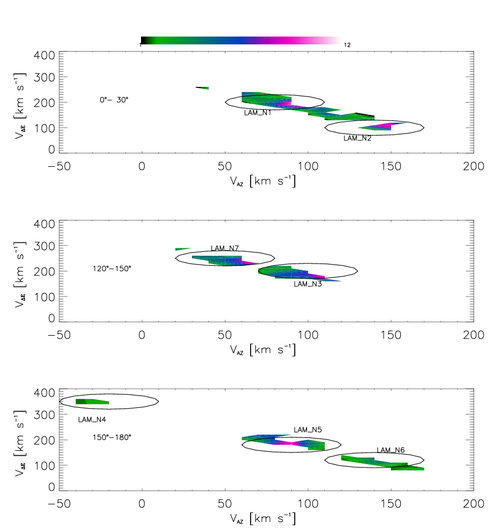Recently, the research team led by Prof. Gang Zhao at National Astronomical Observatories of Chinese Academy of Sciences (NAOC), discovered new accretion evidences of the Milky Way both in kinematic and chemical space using LAMOST spectra. A series of new results have been published in famous international journals including The Astrophysical Journal.
The research team has found seven new moving groups (a stage of stellar stream) in kinematic space, which accounts for half of the total moving groups found in kinematic space by now. In chemical space, they found 33 so-called low-alpha-abundance stars that are different from alpha-enhanced Galactic field halo stars. Both moving groups and low-alpha-abundance stars are thought to be remnants of disrupted dwarf galaxies around the Milky Way.
A stellar stream, which is named due to its stream-like morphology, is an association of stars with common intrinsic features. Stellar streams from accretion are as apparent as spatial overdensity at the beginning, but after several hundred million years, they are torn apart and stretched out by the tidal force. Thus, many stellar streams entering in our Milky Way long time ago cannot be spatially coherent structures, which puts more difficulties on detection. The seven new moving groups and adventive low-alpha-abundance stars belong to this kind of indistinct stellar streams. The referee of the Astrophysical Journal appraised as “The authors provide some insights in terms of chemical evolution of the Galaxy, and how their results corroborate with the currently accepted scenarios. The early results from LAMOST shown in the paper are an important milestone in this project.”
Based on the observed characteristics of the new moving groups, Prof. Gang Zhao and his colleagues propose three kinds of morphology of stellar streams over time, named early stage, middle stage and late stage. Stellar streams in early stage preserve coherent structures in physical space and can be recognized easily. In the middle stage, the stream members may still keep structures in kinematics, but mostly they spread everywhere in space, so the difficulty of detection isincreased significantly. The most difficult case is the late stage. The stream members in late stage lose structures completely in space and kinematics. The only way to find them is to search for the chemical imprint from their parent galaxy through careful analysis of their spectra.
The team has developed a machinery to detect late-stage stellar streams. Prof. Gang Zhao said “This method is like DNA paternity test. We use the chemical DNA of the stars to help find their parent galaxies.” Searching for stellar streams in middle and late stage can help not only understand the galaxy formation but also explore the Galactic potential and its mass distribution.
The new discoveries of the research team led by Prof. Gang Zhao have promoted the detection efficiency of stellar streams in kinematic and chemical space using the data from large spectroscopic survey. Their findings show great advantages and potential of LAMOST to study the Milky Way. The researchers expect that LAMOST in combination with Gaia would find more stellar streams to reveal the mystery of the Milky Way.



Address: 20A Datun Road, Chaoyang District, Beijing, China code: 100012
Tel: 010-64888708 E-mail: naoc@nao.cas.cn

